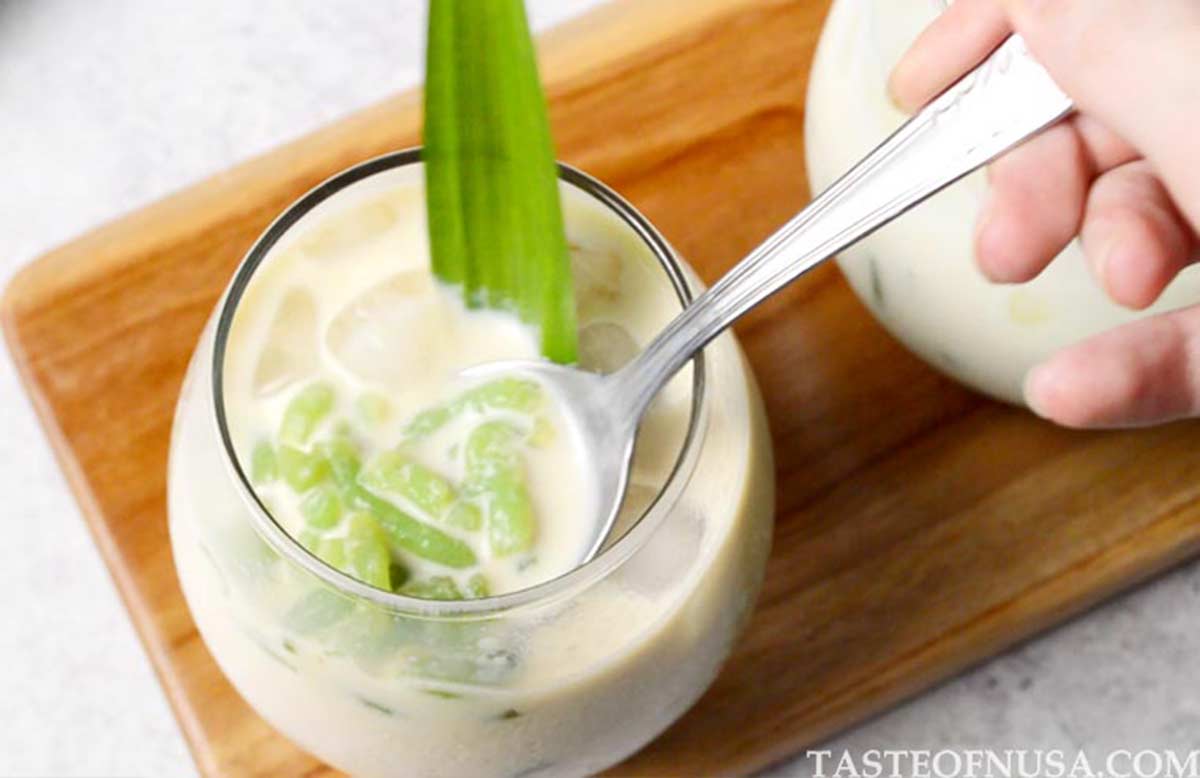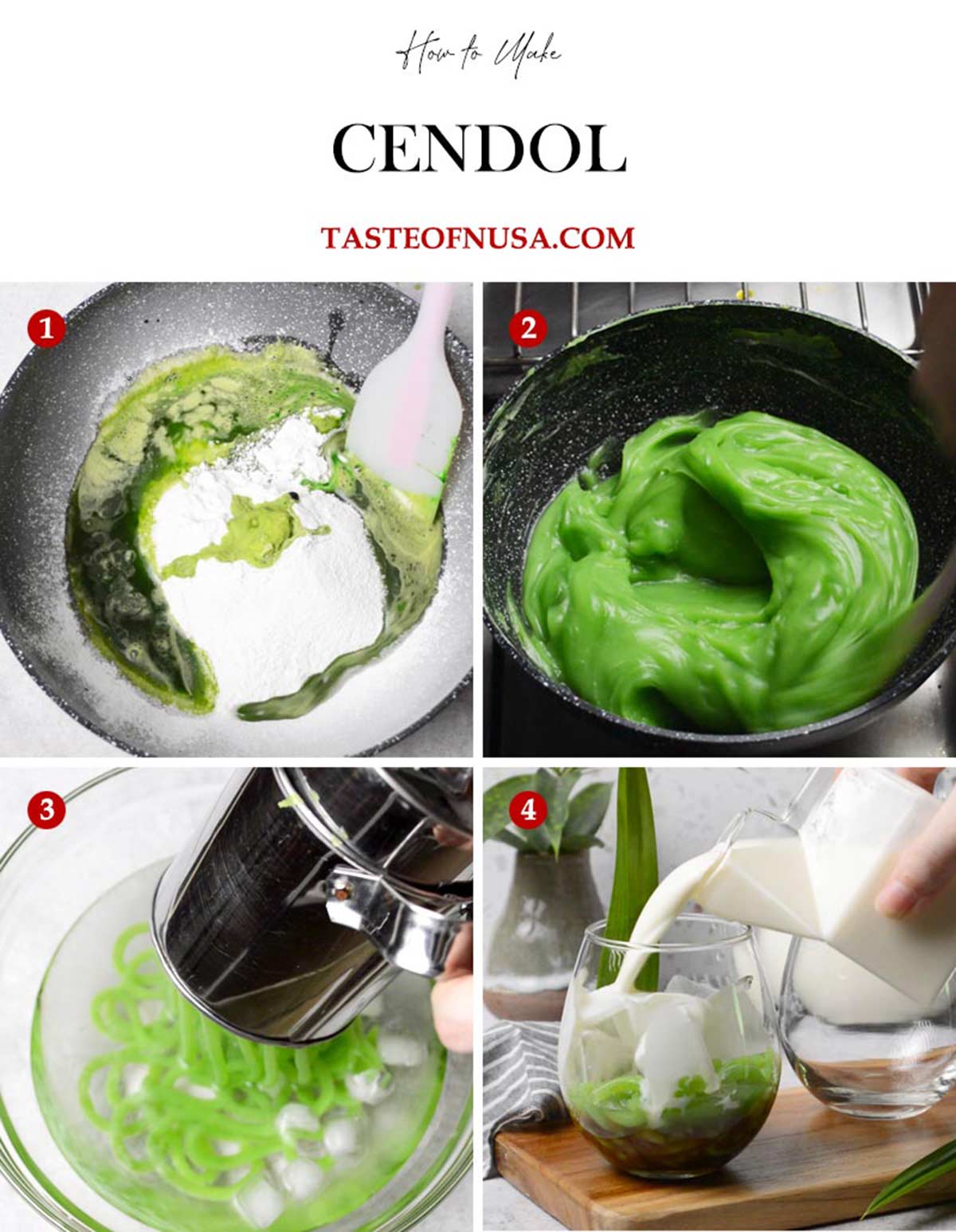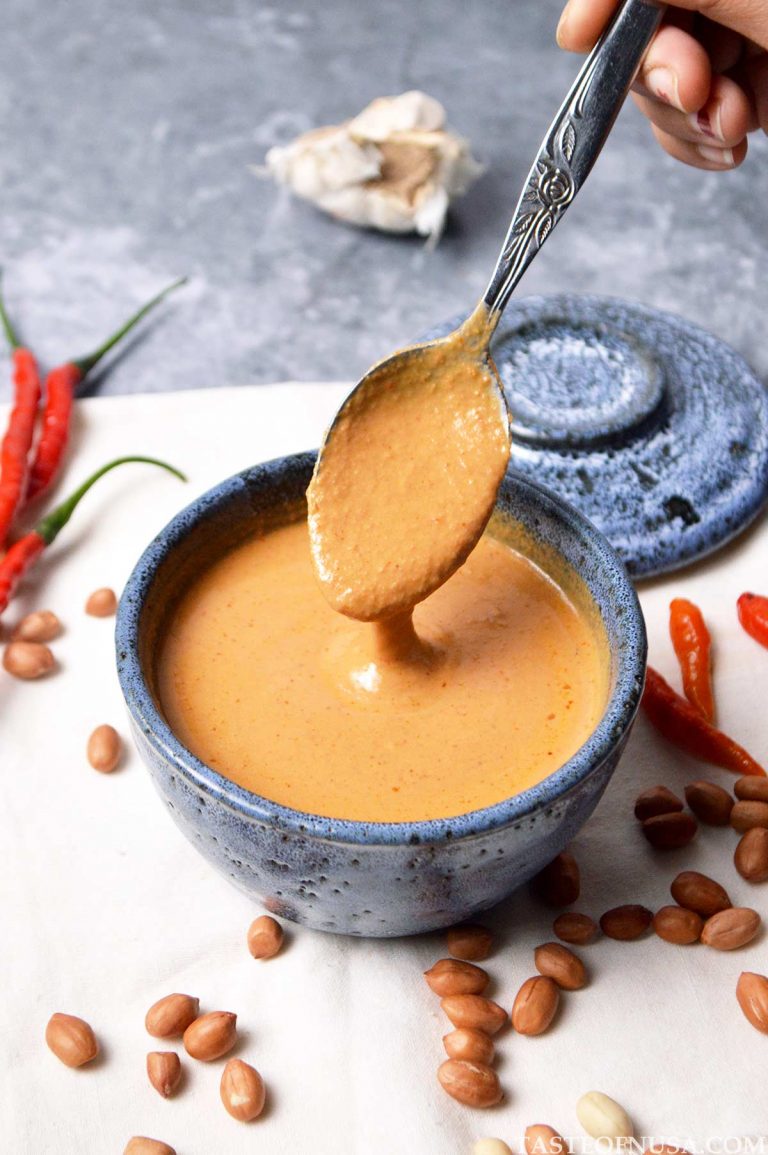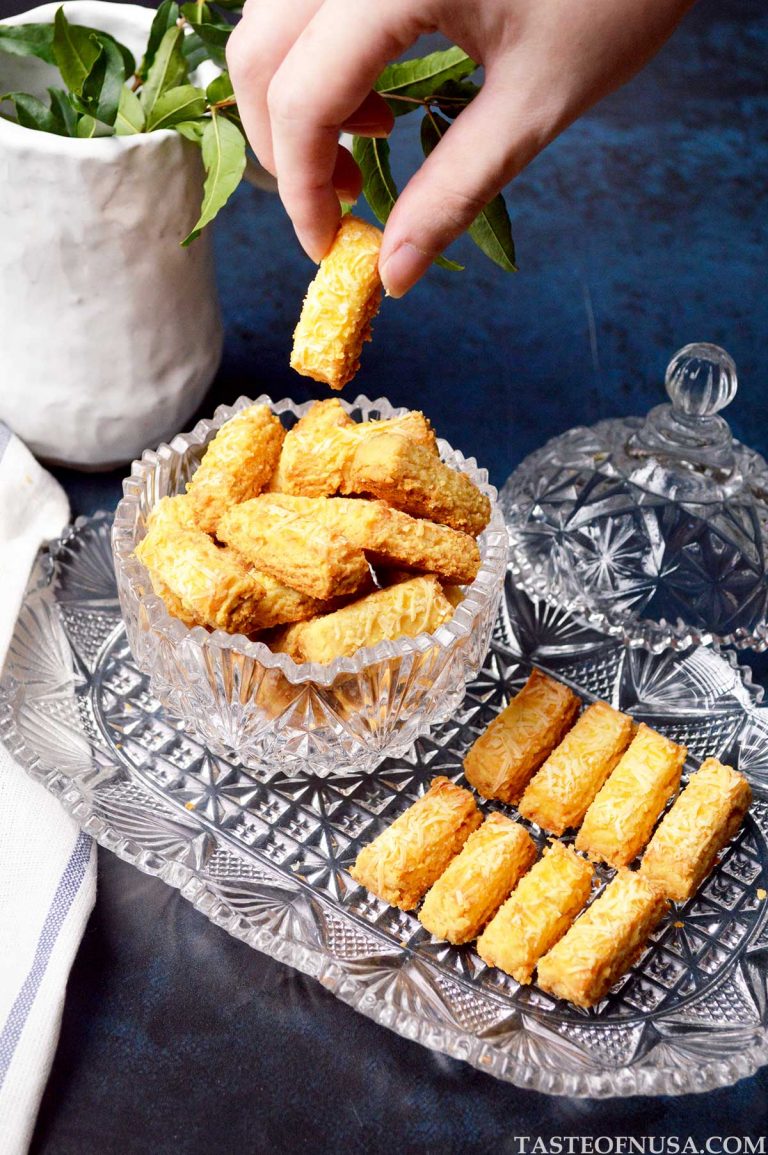Es Cendol
Learn step-by-step how to make Es Cendol with rice flour or mung bean starch for soft or chewy pandan jellies on your dessert. Sweeten cendol with palm sugar syrup and serve with savory coconut milk and ice cubes to cool your summertime!

If you travel to Indonesia or nearby Southeast Asia countries, you will surely find someone serving Es Cendol. Es Cendol is commonly sold at pushcart vendors to fancy restaurants. A cool and refreshing dessert drink to beat the tropical heat.
What is Cendol?
Cendol can mean two meanings:
- Indonesia – The term cendol only refers to the green worm-shaped jellies. In Java, cendol is served on a tall glass with palm sugar, and coconut milk is also known as dawet.
- Malaysia/Singapore – Cendol is an actual dessert as a whole dessert served in a bowl with various ingredients.
Basically, cendol is an iced sweet dessert that contains droplets of green jellies, coconut, and palm sugar syrup. The dessert is commonly found in Southeast Asia.
How Does Cendol Taste Like?
Cendol is usually made with rice flour or mung bean starch, mixed with salt, pandan extract, and water. The cendol itself tastes like nothing, bland, but with a little nutty, grassy taste from the pandan extract. That’s why cendol is usually served with palm sugar syrup and coconut milk. The coconut milk brings sweet-savoriness which, combined with the palm sugar syrup, gives cendol its caramelized taste.

Cendol Variations in Different Countries
Cendol comes in many different variations across Southeast Asia and sometimes goes under different names (please correct me if I am wrong):
Es Cendol or Es Dawet – Indonesia
Unlike elsewhere in Southeast Asia, the word cendol refers to just the green jellies. The finished product is known as es cendol in West Java, and dawet or dawet ayu in East and Central Java. Generally, it will be consumed as a drink which is served in a tall glass. The palm sugar syrup goes in first, followed by the green jelly, and coconut milk. The additional topping includes diced jackfruit, tapai (fermented sweet cassava), durian, and chocolate condensed milk are popular in Indonesia.
Ais Cendol – Malaysia
Traditionally, Malaysians serve cendol as a dessert in a bowl with sweetened red beans. Malaysian cendol will nearly always use gula Melaka palm syrup. Sometimes, cendol is served with additional toppings, such as glutinous rice, grass jelly, cream corn, durian, tapai, and even ice cream might also be included.
Chendol – Singapore
Very similar to the Malaysian version of cendol, Singaporean cendol uses sweetened red beans and palm sugar syrup, served in a bowl.
Lot Chong – Thailand
Lot chong literally translates to ‘gone through a hole’. This is because it is made by pressing warm dough through a sieve into cold water. It is served in a tall glass and consists of green jellies, palm sugar syrup, coconut milk, and shaved ice.
Banh Lot or Che Banh Lot – Vietnam
Banh means ‘anything to do with the flour or dough’, and lot means ‘to fall into’. The dessert is usually served as sweet soups with coconut milk and sugar.
Mont Let Saung – Myanmar
This dessert takes two forms in the country. The first is called htannyet mont let saung which is drizzled with a type of caramel-colored cane sugar and the second, onno mont let saung is served in coconut milk.
Cendol Ingredients
Flour
In Indonesia, the terms cendol and dawet refer to cendol with two different kinds of flour:
- Cendol is made from mung bean starch. Cendol made with mung bean starch has a much firmer and chewier texture than the one made with rice flour. However, cendol made from pure mung bean starch can be too hard, so cornstarch or tapioca starch is typically added to make it more tender.
- Dawet is made from rice flour. Dawet has a softer texture with less chewiness compared to cendol. A little bit of tapioca starch is usually added to make dawet chewier.
Green Coloring
Here are some options for how cendol gets its signature green color:
- Suji leaves – In Indonesia, suji leaves (Dracaena angustifolia) are used to give cendol dark natural green color.
- Pandan leaves – The color of cendol made with pandan extract is usually lighter than the ones made with suji leaves but with more flavor and aroma.
- Store-bought pandan extract– If you can’t find any fresh or frozen pandan leaves, you can alternatively pour a few drops of store-bought pandan extract until you get the desired color.
- Green coloring – The last option, if you can’t find the three ingredients above.
Additional Toppings
In Indonesia, other than the basic ingredients of green jellies, palm sugar syrup, and coconut milk, Es Cendol might be served with additional toppings, such as:
- Diced jackfruit
- Tapai (fermented cassava)
- Durian
- Grass jelly
- Chocolate condensed milk
More add-in ingredients from other countries:
- Sweet red bean
- Sweet corn
- Attap seed
- Agar-agar cubes
- Glutinous rice tapai
- Ice cream
- Split mung beans
Tools to Make Cendol
In Southeast Asia, there are special tools or machines used to create the cendol strands. If you plan to make this recipe, you will need one of these tools below to make cendol:

- Cendol press. It has two parts, the container with holes on the bottom and the presser to push the dough.
- Potato ricer. Make sure to choose the right size of the opening so the strands will not be too thin or thick.
- Colander or perforated tray or slotted spoon. Place the cooked dough and press it through the holes with a spatula or scrapper.
- Plastic bag. I also find some people cut off the tip of the plastic bag and press the batter through it. The hot dough can be hot, so make sure to wrap the bag with a kitchen towel to prevent your hands from getting burnt.
How to Make Cendol

- Choose the type of cendol you are going to make: soft or chewy cendol. If you are going for soft cendol, use rice flour. Meanwhile, use mung bean starch for chewier cendol. Mix the flour, salt, pandan or suji extract, and water until well combined.
- Cook the mixture on low heat and stir constantly until the mixture turns thick and translucent.
- Press the hot dough with a cendol maker over top of an ice bath.
- Serve cendol with ice cubes, palm sugar syrup, and coconut milk. Enjoy!
Es Cendol
Ingredients
Dawet (If Using Rice Flour)
- 1/2 cup (100 gr) rice flour
- 1/2 cup (65 gr) tapioca starch
- 1/2 tsp salt
Cendol (If Using Mung Bean Starch)
- 1/2 cup (60 gr) mung bean starch/hunkwe flour
- 1/2 cup (60 gr) cornstarch
- 1/2 tsp salt
Pandan Extract
- 20-30 pandan leaves
- 3 cups (720 ml) water
Palm Sugar Syrup
- 1 1/2 cups (300 gr) tightly-packed shaved palm sugar block
- 3/4 cup (180 ml) water
- 2 pandan leaves, knotted or chopped
Coconut Milk
- 3 cups (720 ml) coconut milk
- 1/2 tsp salt
- 3 pandan leaves, knotted or chopped
To Serve
- Ice cubes
Instructions
Coconut Milk
- In a medium saucepan, heat coconut milk, salt, and pandan leaves on low heat. Stir constantly until the mixture boils. Set aside and cool completely before using.
Palm Sugar Syrup
- In a small saucepan, heat palm sugar, water, and pandan leaves on medium heat. Stir occasionally until the sugar fully melts. Let the mixture boils. Set aside and cool completely before using.
Pandan Extract
- In a blender or food processor, blend pandan leaves and 1/2 cup water (120 ml) until smooth.
Cendol
- If making dawet – Sift rice flour, tapioca starch, and salt into a pan. Strain the pandan extract into the pan. Add about 1/2 cup water (120 ml). Stir the mixture until well combined with no lumps. Then, add the remaining 2 cups (480 ml) of water and stir until well combined.
- If making cendol – Sift mung bean starch, cornstarch, and salt into a pan. Strain the pandan extract into the pan. Add about 1/2 cup water (120 ml). Stir the mixture until well combined with no lumps. Then, add the remaining 2 cups (480 ml) of water and stir until well combined.
- Cook – Heat the pan over low heat. Stir continuously until the mixture thickens and is translucent.
- Shape cendol – When still hot, transfer the dough into the cendol maker. Squeeze out the paste over the top of the ice bath, ensuring the cendol is submerged in the ice water. Leave the cendol in the ice water for 15 minutes to firm up.
Assemble
- In serving glasses, drizzle in palm sugar syrup. Add ice cubes if desired. Drain the cendol and portion it out into each glass. Pour in the coconut milk. Serve immediately.







